EXHIBIT 99.1
Published on January 6, 2021
Exhibit 99.1
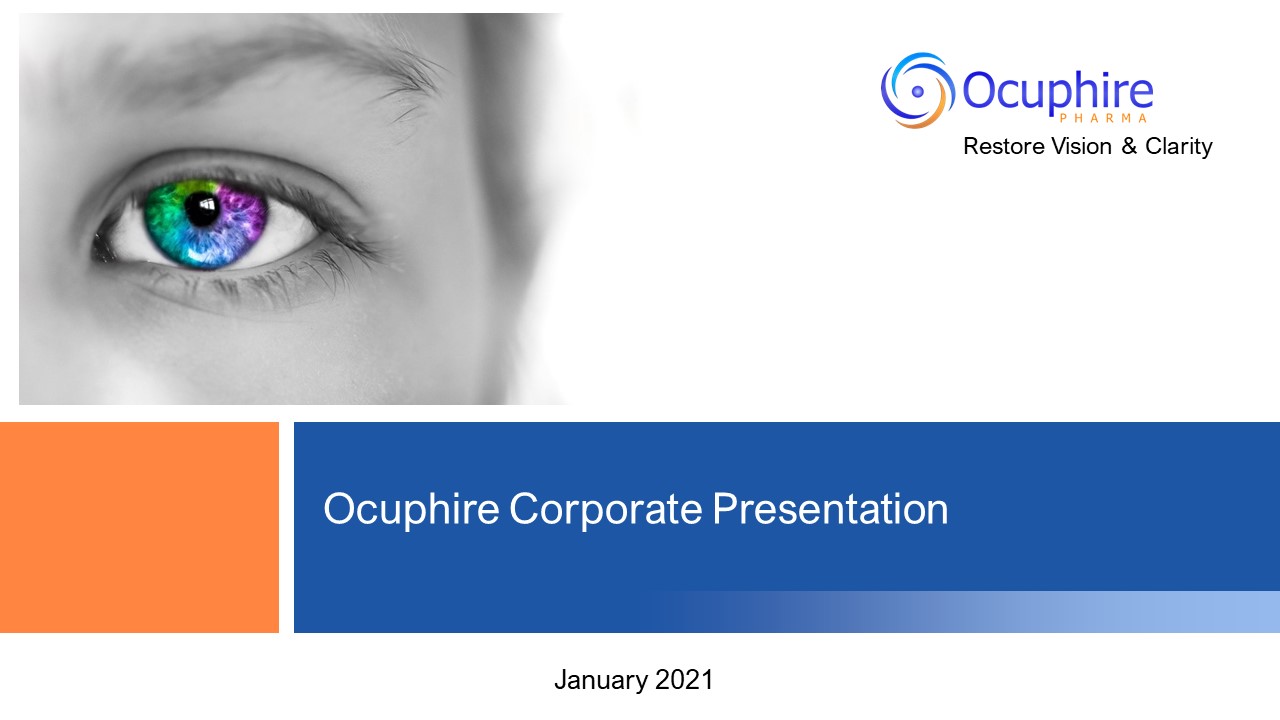
Ocuphire Corporate Presentation January 2021

Disclosures and Forward Looking Statements This presentation contains “forward-looking
statements” within the meaning of the Private Securities Litigation Reform Act of 1995. Such statements include, but are not limited to, statements concerning Ocuphire Pharma, Inc.’s (“Ocuphire” or the “Company”) product candidates and
potential. These forward-looking statements are based upon the Company’s current expectations and involve assumptions that may never materialize or may prove to be incorrect. Actual results and the timing of events could differ materially from
those anticipated in such forward-looking statements as a result of various risks and uncertainties, including, without limitation: (i) potential adverse reactions or changes to business relationships resulting from the announcement or completion
of the merger; (ii) the success and timing of regulatory submissions and pre-clinical and clinical trials; (iii) regulatory requirements or developments; (iv) changes to clinical trial designs and regulatory pathways; (v) changes in capital
resource requirements; (vi) risks related to the inability of the Company to obtain sufficient additional capital to continue to advance its product candidates and its preclinical programs; (vii) legislative, regulatory, political and economic
developments, and (viii) the effects of COVID-19 on clinical programs and business operations. The foregoing review of important factors that could cause actual events to differ from expectations should not be construed as exhaustive and should
be read in conjunction with statements that are included herein and elsewhere, including the risk factors detailed in documents that have been and may be filed by the Company from time to time with the SEC. All forward-looking statements
contained in this presentation speak only as of the date on which they were made. The Company undertakes no obligation to update such statements to reflect events that occur or circumstances that exist after the date on which they were made. The
Company makes no representation or warranty, express or implied, as to the accuracy or completeness of the information contained in or incorporated by reference into this presentation. Nothing contained in or incorporated by reference into this
presentation is, or shall be relied upon as, a promise or representation by the Company as to the past or future. The Company assumes no responsibility for the accuracy or completeness of any such information. This presentation may not be
reproduced or provided to any other person (other than your advisor) without our prior written consent. By accepting delivery of this presentation, you agree to the foregoing and agree to return this presentation and any documents related
thereto and any copies thereof to us or to destroy the same if you do not make an investment in any securities. The information contain within this presentation shall not, except as hereinafter provided, without the prior written consent of the
Company, be disclosed by you or your representatives in any manner whatsoever, in whole or in part, and shall not be used by you or your representatives other than for the purpose of evaluating the transaction described herein. By accepting
delivery of this presentation you further acknowledge and agree aware of the restrictions imposed by the United States securities laws on the purchase or sale of securities by any person who has received material, nonpublic information from the
issuer of the securities or any affiliate thereof and on the communication of such information to any other person when it is reasonably foreseeable that such other person is likely to purchase or sell such securities in reliance on such
information for so long as the information remains material and non-public. This presentation also contains estimates and other statistical data made by independent parties and by us relating to market shares and other data about our industry.
This data involves a number of assumptions and limitations, and you are cautioned not to give undue weight to such estimates. The trademarks included herein are the property of the owners thereof and are used for reference purposes only. Such
use should not be construed as an endorsement of such products. November 6, 2020

Late Clinical Stage Company Targeting Large, Unmet Ophthalmic Markets Significant Clinical
Data and Regulatory Precedents Significant IP Portfolio and Small Molecule CMC Advantages Multiple Near-Term Data Catalysts with Capital Efficient Plan Nyxol eye drops target multiple chronic and acute front of the eye indications addressing
large markets: Dim Light / Night Vision Disturbances (NVD), Reversal of Mydriasis (RM), & Presbyopia (P)APX3330 tablets target chronic back of the eye indications: Diabetic Retinopathy (DR) and Diabetic Macular Edema (DME), a leading cause of
blindness in diabetic patients Nyxol and APX3330 achieved promising clinical data over multiple Phase 1 and 2 trialsNyxol with > 150 patients treated across 7 trialsAPX3330 with > 340 patients treated across 11 trialsFDA End of Phase 2
meeting guidance for Nyxol (all indications) in May 2020 US and global issued patents thru 2034 obtained for both assetsStable, small-molecule drugsNyxol = single-use, preservative-free eye dropAPX3330 = oral pill 4 late-stage trial readouts (2
Phase 3, 2 Phase 2) expected in 1Q through 4Q 2021$20+M financing provides sufficient cash to run capital-efficient ophthalmic-focused operations in 2021Analyst research coverage initiated by Cantor Fitzgerald and Encode IdeasNyxol NDA filing in
one or more indications targeted for early 2023 Ocuphire Opportunity A Late-Stage Clinical Ophthalmic Biotech (Nasdaq Symbol: OCUP) Nyxol® APX3330
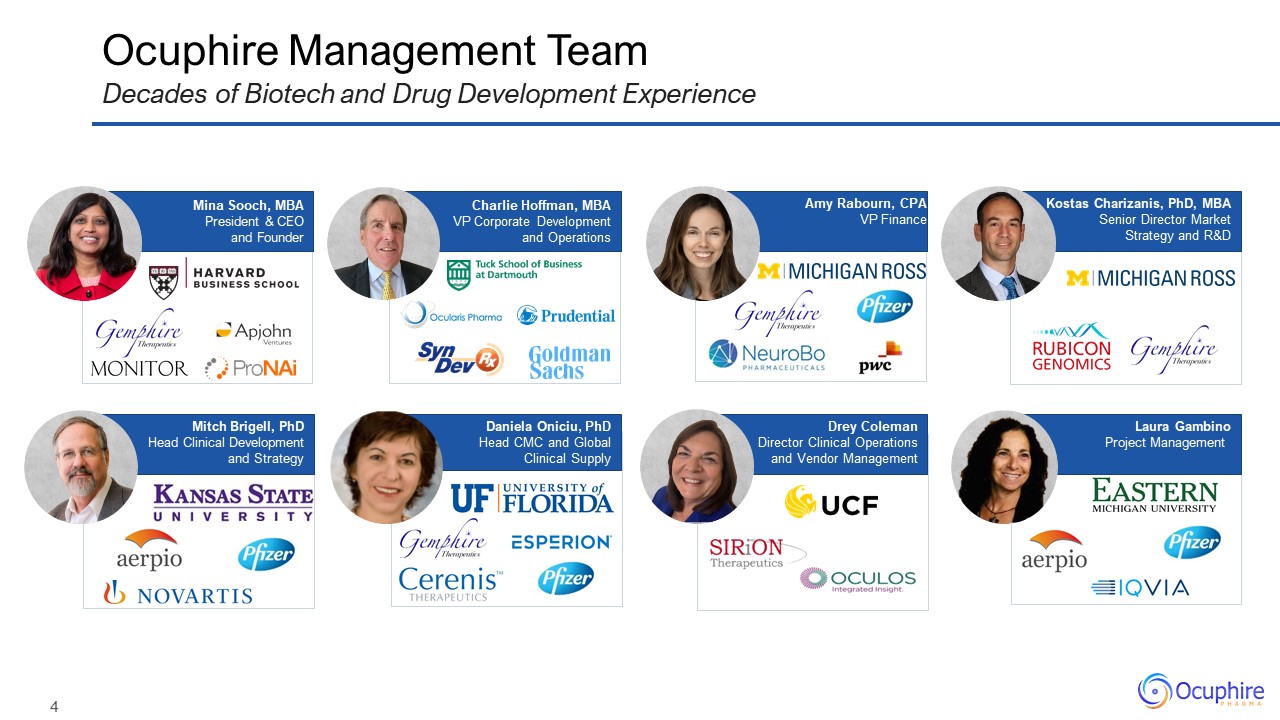
Ocuphire Management Team Decades of Biotech and Drug Development Experience Amy
Rabourn, CPAVP Finance Daniela Oniciu, PhDHead CMC and Global Clinical Supply Kostas Charizanis, PhD, MBASenior Director Market Strategy and R&D Mitch Brigell, PhDHead Clinical Development and Strategy Laura GambinoProject Management
Drey ColemanDirector Clinical Operations and Vendor Management Charlie Hoffman, MBAVP Corporate Development and Operations Mina Sooch, MBAPresident & CEO and Founder
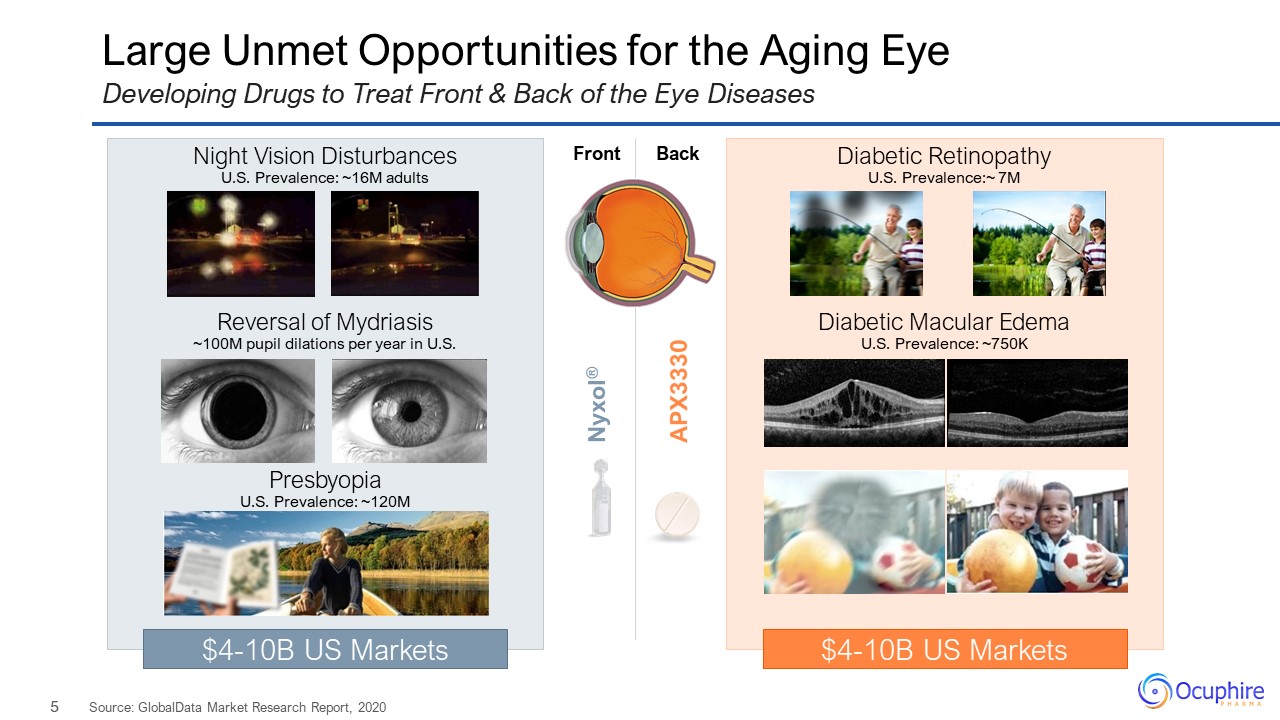
Large Unmet Opportunities for the Aging Eye Source: GlobalData Market Research Report,
2020 Developing Drugs to Treat Front & Back of the Eye Diseases Back Front PresbyopiaU.S. Prevalence: ~120M Night Vision DisturbancesU.S. Prevalence: ~16M adults Reversal of Mydriasis~100M pupil dilations per year in
U.S. Nyxol® APX3330 $4-10B US Markets $4-10B US Markets Diabetic Macular EdemaU.S. Prevalence: ~750K Diabetic RetinopathyU.S. Prevalence:~ 7M
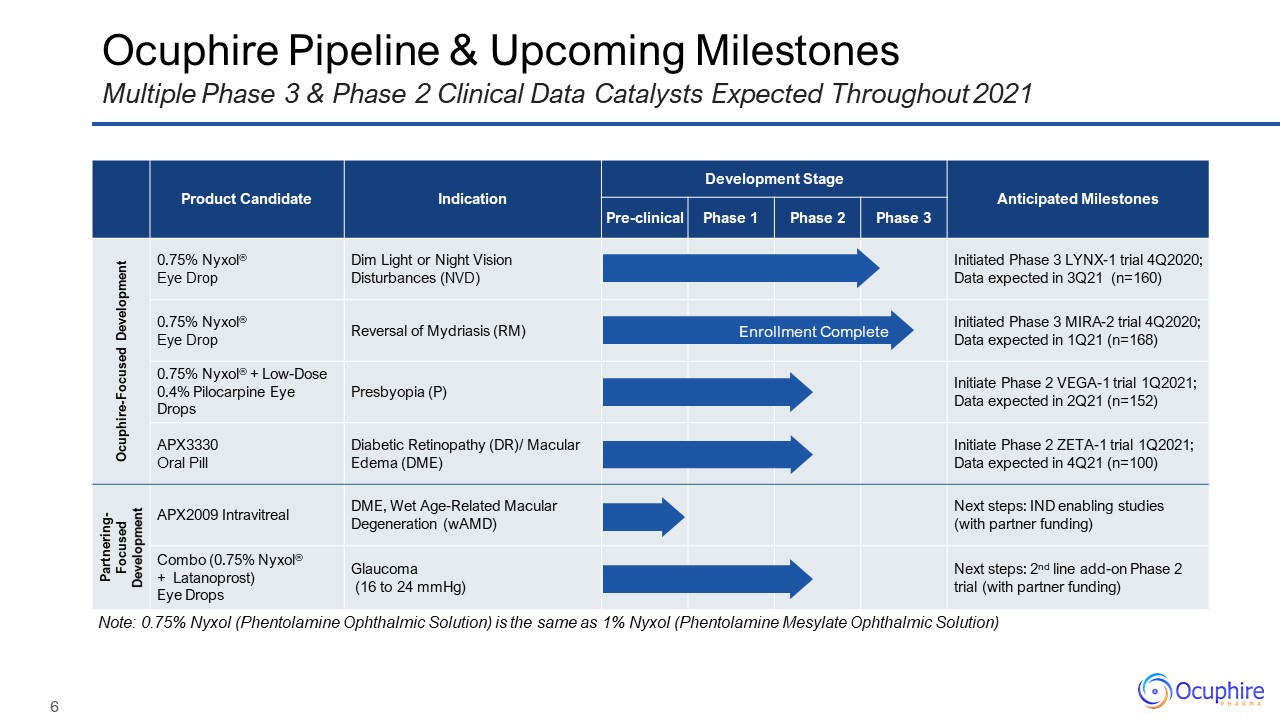
Product Candidate Indication Development Stage Anticipated
Milestones Pre-clinical Phase 1 Phase 2 Phase 3 Ocuphire-Focused Development 0.75% Nyxol®Eye Drop Dim Light or Night Vision Disturbances (NVD) Initiated Phase 3 LYNX-1 trial 4Q2020;Data expected in 3Q21 (n=160) 0.75%
Nyxol®Eye Drop Reversal of Mydriasis (RM) Initiated Phase 3 MIRA-2 trial 4Q2020; Data expected in 1Q21 (n=168) 0.75% Nyxol® + Low-Dose 0.4% Pilocarpine Eye Drops Presbyopia (P) Initiate Phase 2 VEGA-1 trial 1Q2021;Data
expected in 2Q21 (n=152) APX3330 Oral Pill Diabetic Retinopathy (DR)/ Macular Edema (DME) Initiate Phase 2 ZETA-1 trial 1Q2021;Data expected in 4Q21 (n=100) Partnering-Focused Development APX2009 Intravitreal DME, Wet Age-Related
Macular Degeneration (wAMD) Next steps: IND enabling studies (with partner funding) Combo (0.75% Nyxol® + Latanoprost) Eye Drops Glaucoma (16 to 24 mmHg) Next steps: 2nd line add-on Phase 2 trial (with partner
funding) Ocuphire Pipeline & Upcoming Milestones Multiple Phase 3 & Phase 2 Clinical Data Catalysts Expected Throughout 2021 Enrollment Complete Note: 0.75% Nyxol (Phentolamine Ophthalmic Solution) is the same as 1% Nyxol
(Phentolamine Mesylate Ophthalmic Solution)

11Phase 1 & Phase 2 Trials >340Subjects Dosed Exposure in Humans 365 Days Patents
to2034+ Extensive Development on Both Drug Candidates Well-Controlled Phase 1 & Phase 2 Clinical Programs Set Stage for NDA Path NCE Development Pathway Studied in inflammation/hepatitis & cancer patients 7Phase 1 & Phase 2
Trials > 150Subjects Dosed Exposure in Humans28Days Patents to2034+ 505(b)(2) Development Pathway Studied in ocular refractory diseases (NVD) & elderly glaucoma patients Nyxol APX3330
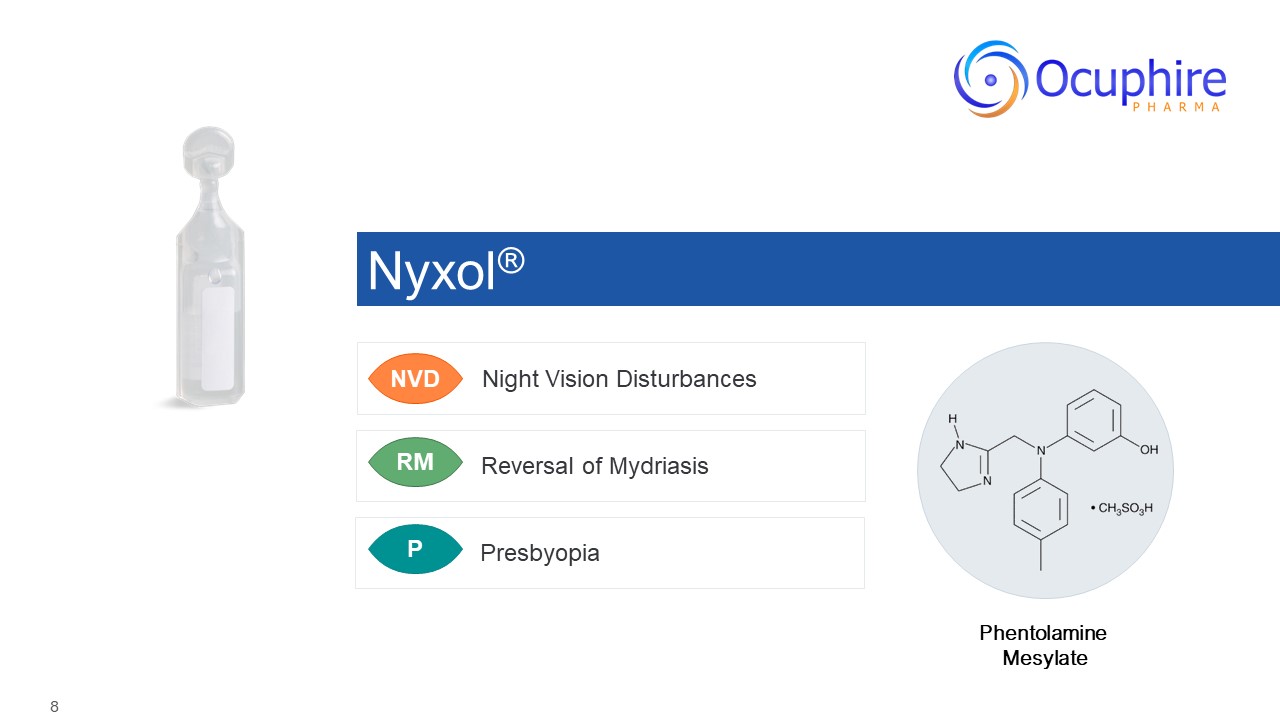
Nyxol® Phentolamine Mesylate NVD Night Vision Disturbances P Presbyopia RM Reversal of
Mydriasis
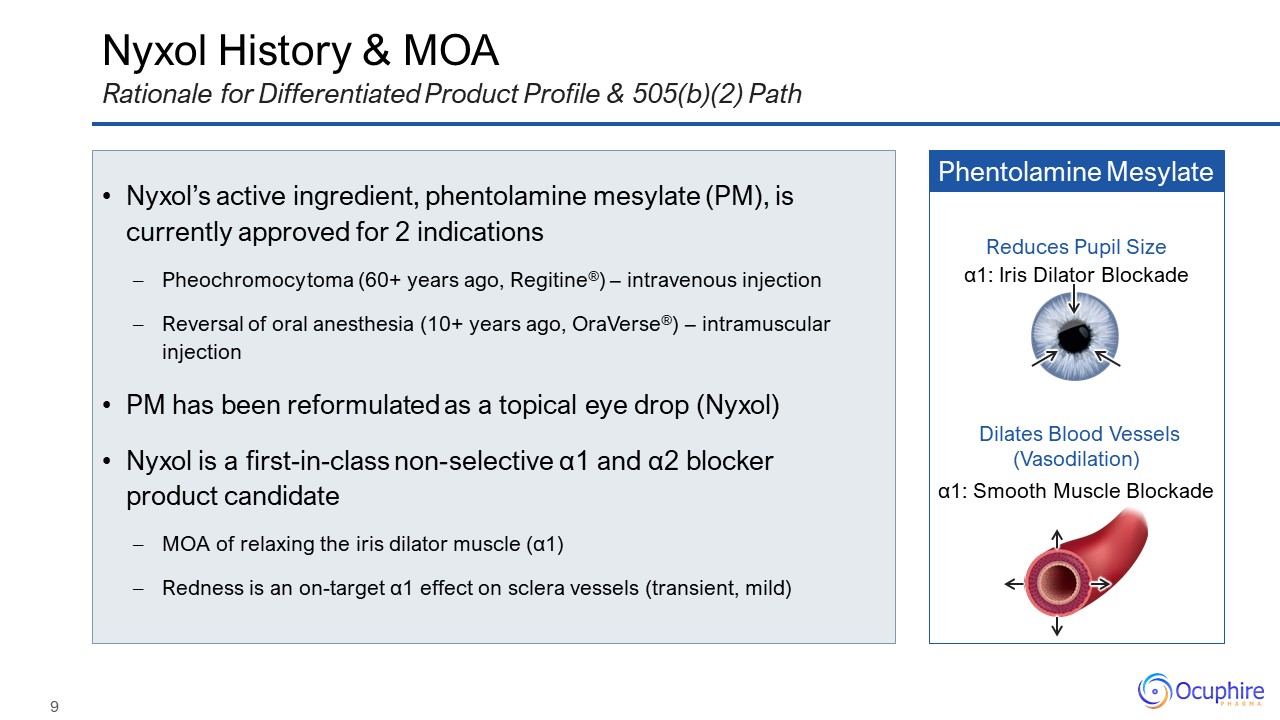
Nyxol History & MOA Nyxol’s active ingredient, phentolamine mesylate (PM), is currently
approved for 2 indicationsPheochromocytoma (60+ years ago, Regitine®) – intravenous injectionReversal of oral anesthesia (10+ years ago, OraVerse®) – intramuscular injectionPM has been reformulated as a topical eye drop (Nyxol)Nyxol is a
first-in-class non-selective α1 and α2 blocker product candidateMOA of relaxing the iris dilator muscle (α1)Redness is an on-target α1 effect on sclera vessels (transient, mild) Rationale for Differentiated Product Profile & 505(b)(2)
Path Phentolamine Mesylate Reduces Pupil Size Dilates Blood Vessels (Vasodilation) α1: Smooth Muscle Blockade α1: Iris Dilator Blockade

Improving Vision↓ Pupil Size (moderate miotic)↑ Contrast Sensitivity (night)↑ Near Visual
Acuity (light/dark)↑ Distance Visual Acuity No Systemic EffectsNo Changes in Blood PressureNo Changes in Heart RateTolerated Topical EffectsMild / Transient / Reversible Eye RednessIOP Unchanged or Decreased↓ Intraocular Pressure (IOP) at Normal
Baseline Nyxol Product Candidate Profile First-in-Class Alpha 1/2 Blocker Eye Drop for Refractory Indications Safety Data Efficacy Data Nyxol: Phentolamine 0.75% Ophthalmic SolutionPreservative Free, EDTA Free, and Stable Chronic daily
dosing of Nyxol at bedtime demonstrated no significant daytime redness and durability of effects for more than 24 hours

Moderate-to-Severe NVDs US Patients Night Myopia 10.8M Cortical
Cataracts 4.1M Post-LASIK 500k Post-IOL Implant 300k Total ~16M Night Vision Disturbances (NVD) – Chronic Opportunity Peripheral imperfections scatter light when pupils enlarge in dim light, causing halos, starbursts, and glare that
impair visionThe imperfections may be caused by LASIK surgery, IOL implants, certain types of cataracts (cortical), and natural reasons (especially with age) Symptoms cannot be properly corrected by any type of lens (reading glasses, contact
lenses) or surgical procedures Source: GlobalData Market Research Report, 2020 The Problem Imperfections in the Eye Affect Night Vision in Millions No Currently Approved Therapies NVD I’m no longer comfortable driving at night,
especially with my son in the car. I have a hard time playing beach volleyball in the evenings due to the bright lights at the courts. Post-LASIK, aged 42
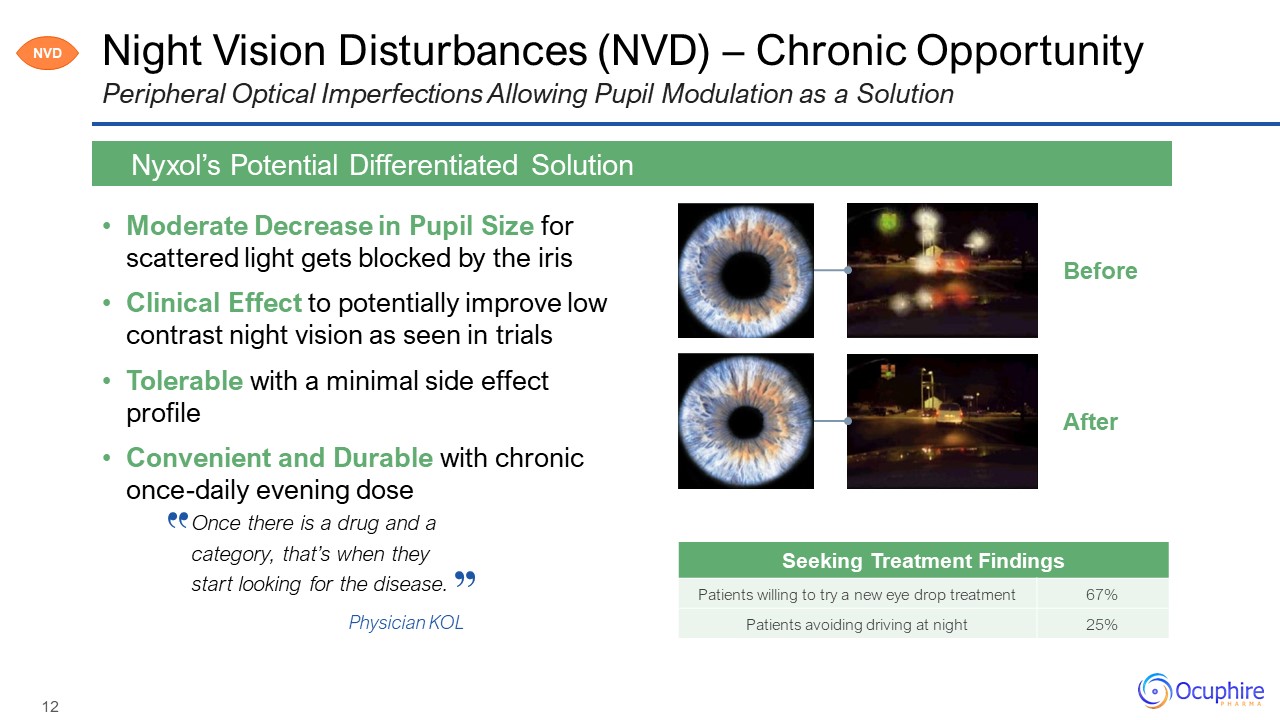
Night Vision Disturbances (NVD) – Chronic Opportunity Moderate Decrease in Pupil Size for
scattered light gets blocked by the iris Clinical Effect to potentially improve low contrast night vision as seen in trialsTolerable with a minimal side effect profile Convenient and Durable with chronic once-daily evening dose Nyxol’s Potential
Differentiated Solution Peripheral Optical Imperfections Allowing Pupil Modulation as a Solution After Before NVD Once there is a drug and a category, that’s when they start looking for the disease. Physician KOL Seeking Treatment
Findings Patients willing to try a new eye drop treatment 67% Patients avoiding driving at night 25%
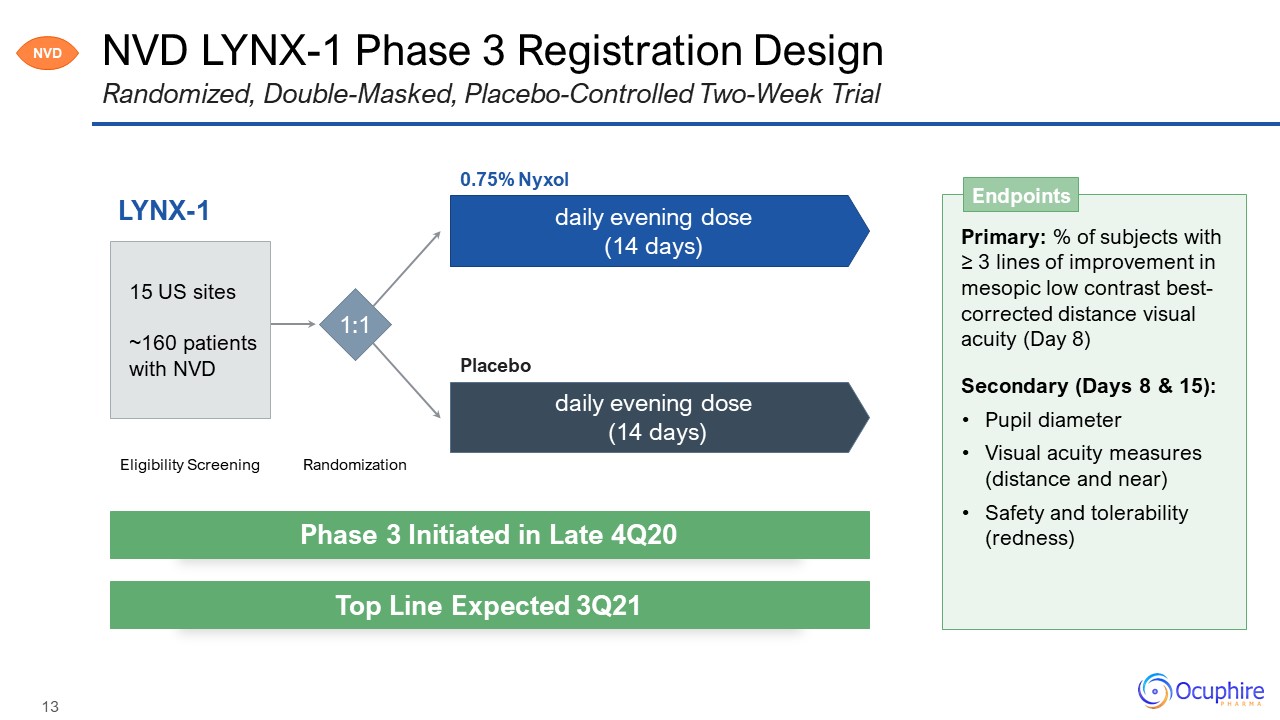
NVD LYNX-1 Phase 3 Registration Design Randomized, Double-Masked, Placebo-Controlled
Two-Week Trial LYNX-1 Primary: % of subjects with ≥ 3 lines of improvement in mesopic low contrast best-corrected distance visual acuity (Day 8)Secondary (Days 8 & 15):Pupil diameterVisual acuity measures (distance and near)Safety and
tolerability (redness) Endpoints Eligibility Screening Randomization 1:1 daily evening dose(14 days) daily evening dose (14 days) 0.75% Nyxol Placebo 15 US sites~160 patients with NVD NVD Phase 3 Initiated in Late 4Q20 Top Line
Expected 3Q21
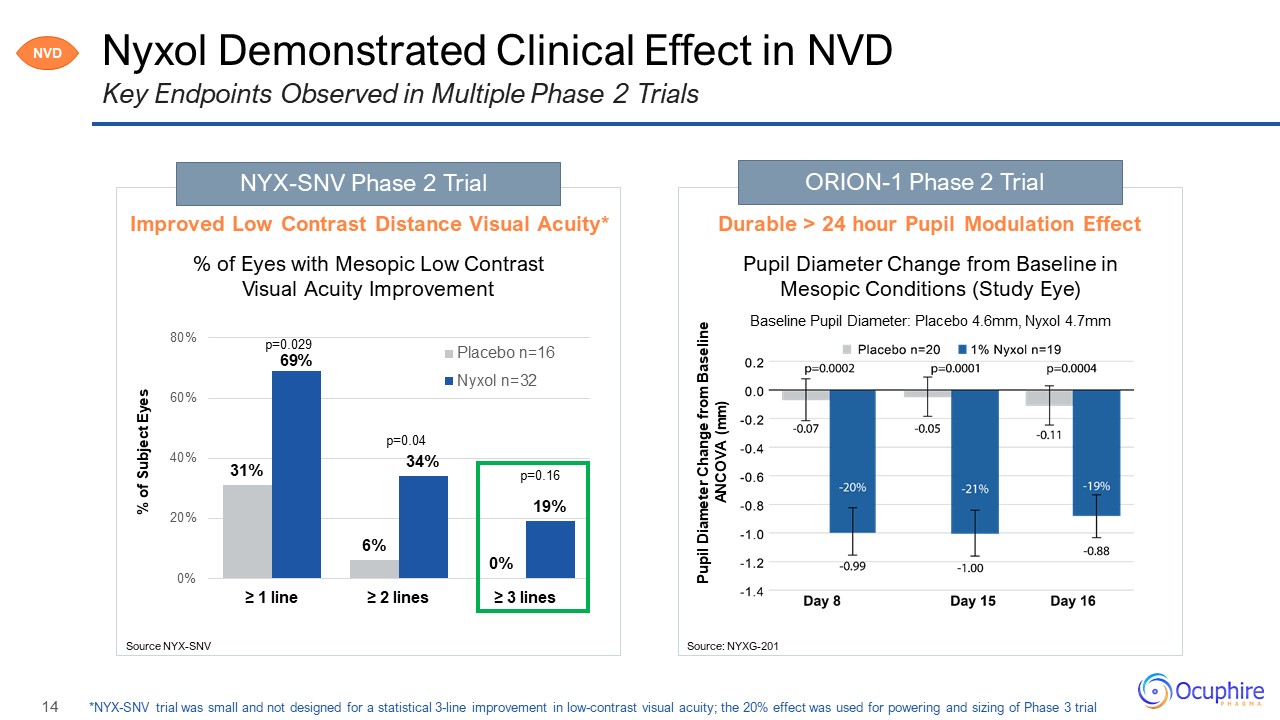
ORION-1 Phase 2 Trial NYX-SNV Phase 2 Trial Nyxol Demonstrated Clinical Effect in
NVD Key Endpoints Observed in Multiple Phase 2 Trials Improved Low Contrast Distance Visual Acuity* Source: NYXG-201 Durable > 24 hour Pupil Modulation Effect % of Eyes with Mesopic Low Contrast Visual Acuity Improvement Pupil Diameter
Change from Baseline in Mesopic Conditions (Study Eye) Source NYX-SNV % of Subject Eyes p=0.029 p=0.04 p=0.16 Pupil Diameter Change from BaselineANCOVA (mm) Baseline Pupil Diameter: Placebo 4.6mm, Nyxol 4.7mm NVD *NYX-SNV trial was
small and not designed for a statistical 3-line improvement in low-contrast visual acuity; the 20% effect was used for powering and sizing of Phase 3 trial
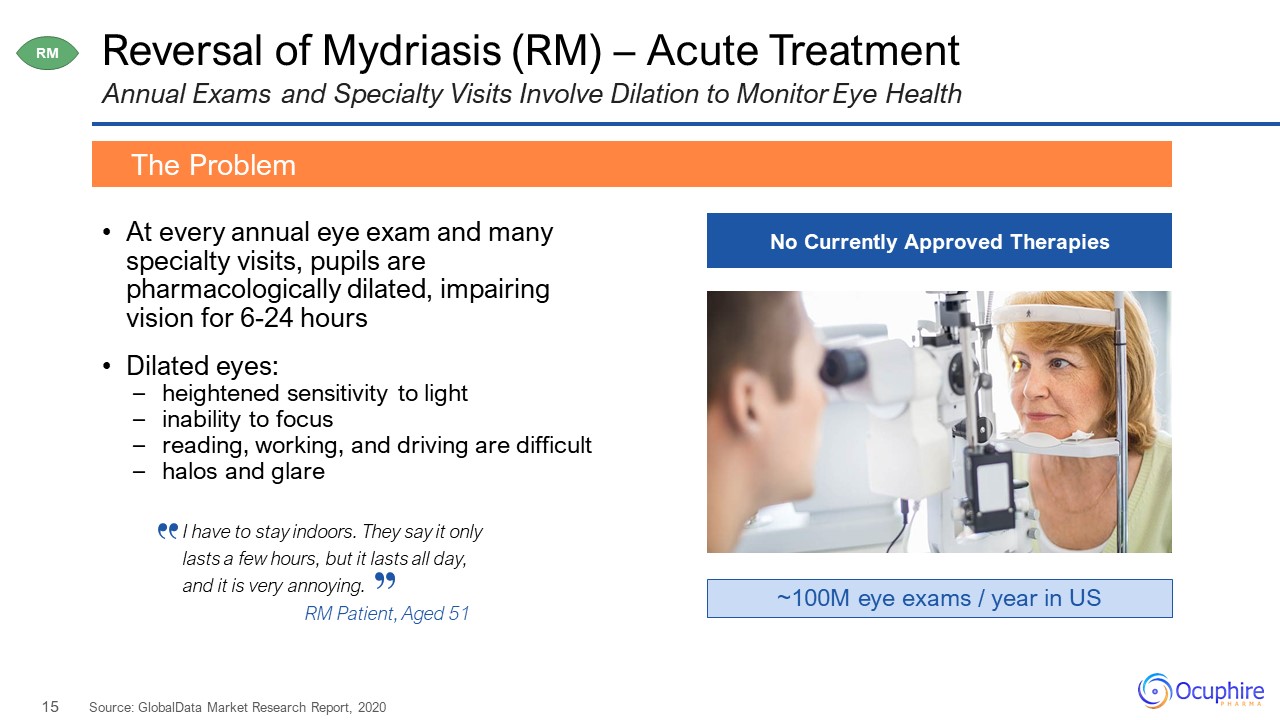
Reversal of Mydriasis (RM) – Acute Treatment At every annual eye exam and many specialty
visits, pupils are pharmacologically dilated, impairing vision for 6-24 hoursDilated eyes:heightened sensitivity to light inability to focus reading, working, and driving are difficult halos and glare The Problem Annual Exams and Specialty
Visits Involve Dilation to Monitor Eye Health ~100M eye exams / year in US No Currently Approved Therapies RM Source: GlobalData Market Research Report, 2020 I have to stay indoors. They say it only lasts a few hours, but it lasts all day,
and it is very annoying. RM Patient, Aged 51
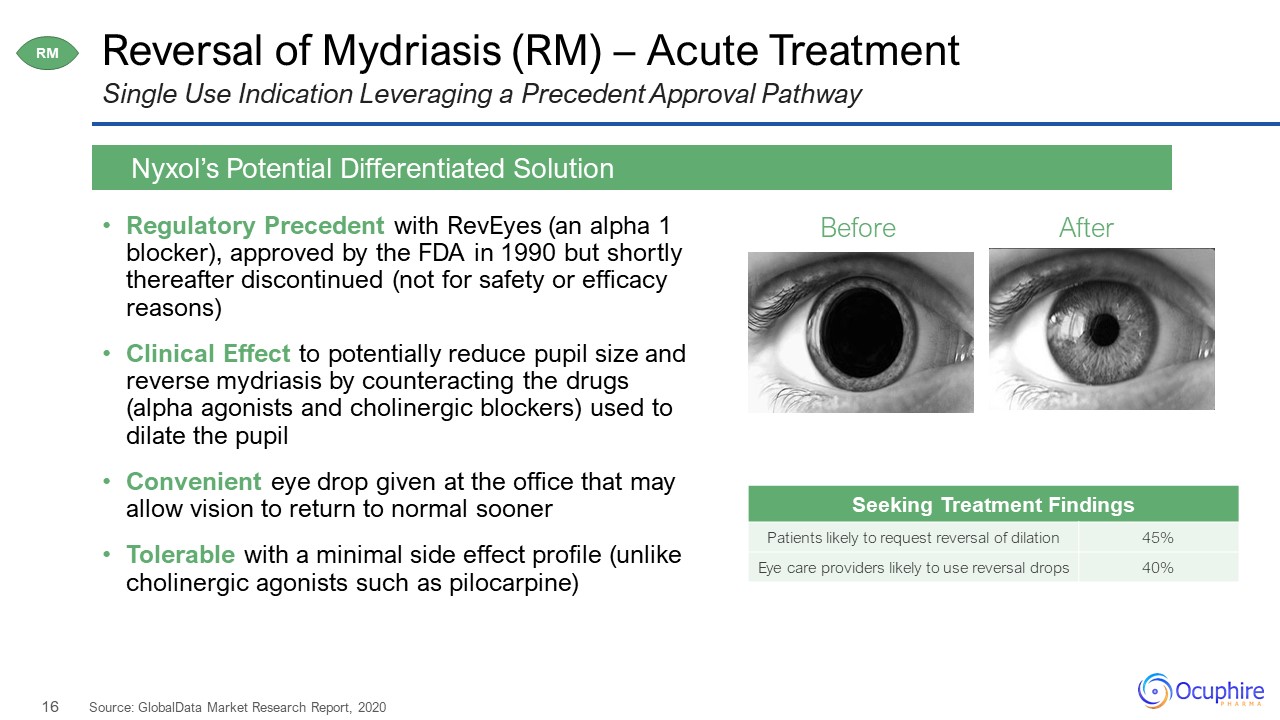
After Before Reversal of Mydriasis (RM) – Acute Treatment Regulatory Precedent with RevEyes
(an alpha 1 blocker), approved by the FDA in 1990 but shortly thereafter discontinued (not for safety or efficacy reasons)Clinical Effect to potentially reduce pupil size and reverse mydriasis by counteracting the drugs (alpha agonists and
cholinergic blockers) used to dilate the pupilConvenient eye drop given at the office that may allow vision to return to normal soonerTolerable with a minimal side effect profile (unlike cholinergic agonists such as pilocarpine) Nyxol’s
Potential Differentiated Solution Single Use Indication Leveraging a Precedent Approval Pathway RM Seeking Treatment Findings Patients likely to request reversal of dilation 45% Eye care providers likely to use reversal
drops 40% Source: GlobalData Market Research Report, 2020
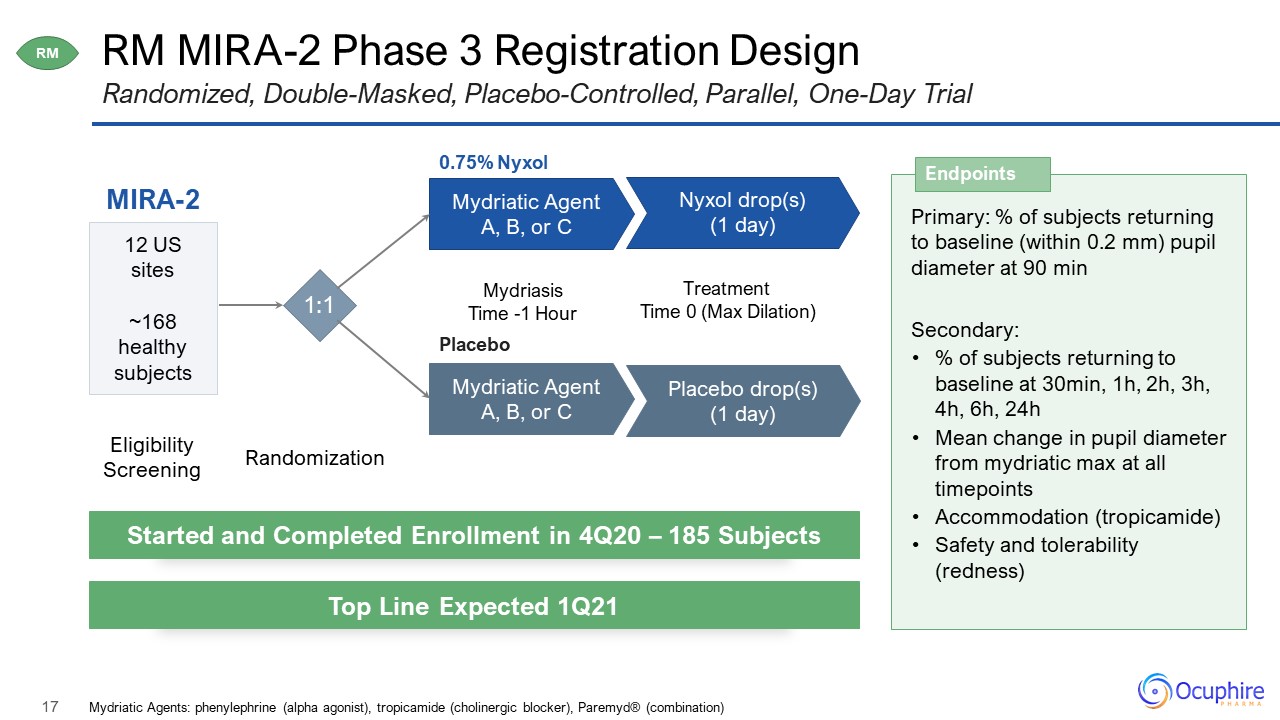
RM MIRA-2 Phase 3 Registration Design Randomized, Double-Masked, Placebo-Controlled, Parallel,
One-Day Trial MydriasisTime -1 Hour MIRA-2 1:1 Mydriatic Agent A, B, or C 0.75% Nyxol Placebo 12 US sites~168 healthy subjects Nyxol drop(s)(1 day) Mydriatic Agent A, B, or C Placebo drop(s)(1 day) Treatment Time 0 (Max
Dilation) RM Primary: % of subjects returning to baseline (within 0.2 mm) pupil diameter at 90 minSecondary:% of subjects returning to baseline at 30min, 1h, 2h, 3h, 4h, 6h, 24hMean change in pupil diameter from mydriatic max at all
timepointsAccommodation (tropicamide)Safety and tolerability (redness) Endpoints Started and Completed Enrollment in 4Q20 – 185 Subjects Top Line Expected 1Q21 Eligibility Screening Randomization Mydriatic Agents: phenylephrine (alpha
agonist), tropicamide (cholinergic blocker), Paremyd® (combination) 1:1
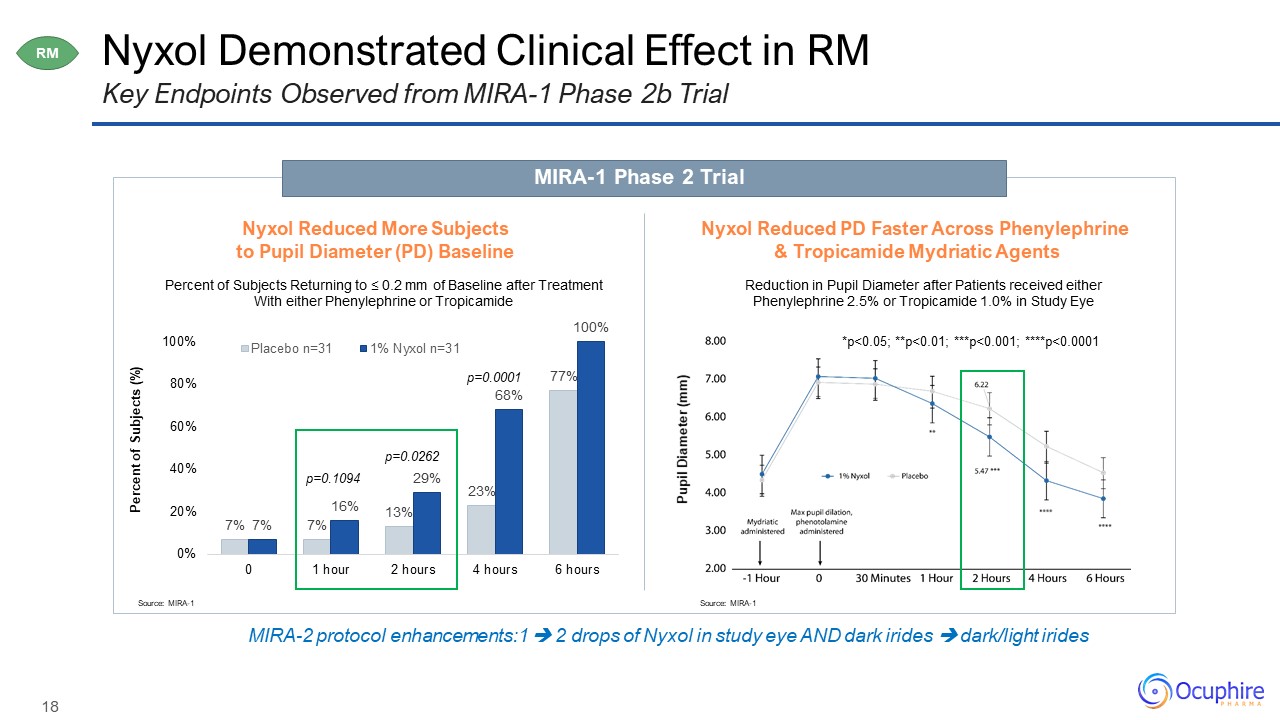
Nyxol Demonstrated Clinical Effect in RM Key Endpoints Observed from MIRA-1 Phase 2b
Trial MIRA-1 Phase 2 Trial Nyxol Reduced More Subjects to Pupil Diameter (PD) Baseline Source: MIRA-1 Nyxol Reduced PD Faster Across Phenylephrine & Tropicamide Mydriatic Agents Source: MIRA-1 RM Percent of Subjects Returning to ≤ 0.2
mm of Baseline after TreatmentWith either Phenylephrine or Tropicamide Reduction in Pupil Diameter after Patients received eitherPhenylephrine 2.5% or Tropicamide 1.0% in Study Eye Percent of Subjects (%) p=0.1094 p=0.0262 p=0.0001 Pupil
Diameter (mm) *p<0.05; **p<0.01; ***p<0.001; ****p<0.0001 MIRA-2 protocol enhancements:1 2 drops of Nyxol in study eye AND dark irides dark/light irides

Presbyopia – Chronic Opportunity Lens loses ability to change shape when viewing objects up
close as we ageDependence on reading glasses for intermittent and prolonged useGrowing need for therapies that improve, rather than hinder, quality of life Source: GlobalData Market Research Report, 2020 The Problem Aging Population Drives
Demand for Alternatives to Reading Glasses P 120 M Patients No Currently Approved Drug Therapies Effectively everyone over 40 will have the problems with reading. Physician KOL Seeking Treatment Findings Patients requesting
alternative to reading glasses 40% Patients would consider an eye drop alternative 69%

Presbyopia – Chronic Opportunity “Pin-hole” effect of Nyxol and low dose pilocarpine may
improve near vision by increasing depth of focus as validated by other devices/therapiesMore durable combination of two miotics affecting different muscles (iris dilator and sphincter) involved in pupil size modulationTolerable use with minimal
side effects expected with chronic evening use of Nyxol Retinaeyedoctor.com, GlobalData Market Research Report, 2020 Nyxol’s Potential Differentiated Solution Pupil Modulation Eye Drops May Replace Reading Glasses Large Pupil Pin-hole
Pupil Near Far In focus In focus P This would just become part of my daily routine for my eyes to be able to see things up close. How convenient is that? Presbyopic Patient, age 49
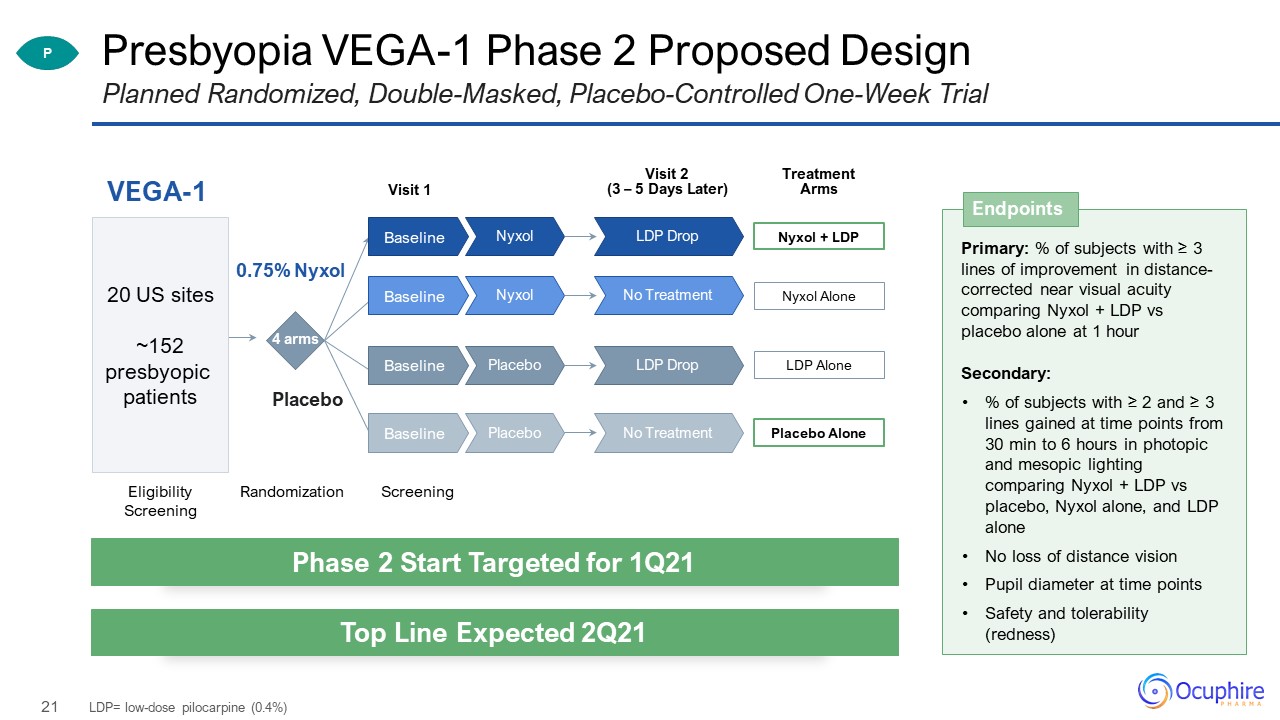
Presbyopia VEGA-1 Phase 2 Proposed Design Planned Randomized, Double-Masked,
Placebo-Controlled One-Week Trial Visit 1 VEGA-1 Eligibility Screening Randomization 4 arms 0.75% Nyxol Placebo 20 US sites~152 presbyopic patients Visit 2 (3 – 5 Days Later) Screening P Primary: % of subjects with ≥ 3 lines of
improvement in distance-corrected near visual acuity comparing Nyxol + LDP vs placebo alone at 1 hourSecondary:% of subjects with ≥ 2 and ≥ 3 lines gained at time points from 30 min to 6 hours in photopic and mesopic lighting comparing Nyxol +
LDP vs placebo, Nyxol alone, and LDP aloneNo loss of distance vision Pupil diameter at time pointsSafety and tolerability (redness) Endpoints Phase 2 Start Targeted for 1Q21 Top Line Expected 2Q21 LDP= low-dose pilocarpine (0.4%) Treatment
Arms Nyxol + LDP LDP Drop Nyxol Baseline Nyxol Alone No Treatment Nyxol Baseline LDP Alone LDP Drop Placebo Baseline Placebo Alone No Treatment Placebo Baseline
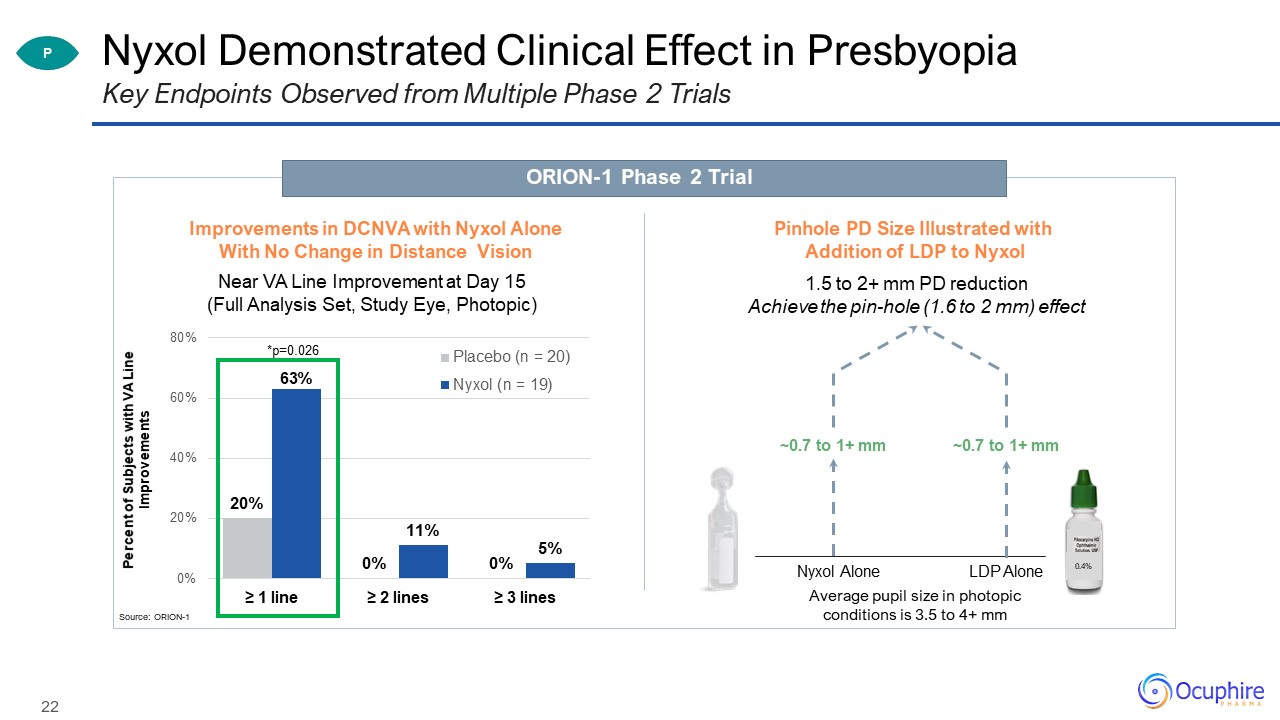
Nyxol Demonstrated Clinical Effect in Presbyopia Key Endpoints Observed from Multiple
Phase 2 Trials Average pupil size in photopic conditions is 3.5 to 4+ mm Source: ORION-1 0.4% 1.5 to 2+ mm PD reductionAchieve the pin-hole (1.6 to 2 mm) effect Nyxol Alone LDP Alone Near VA Line Improvement at Day 15(Full
Analysis Set, Study Eye, Photopic) ~0.7 to 1+ mm P ORION-1 Phase 2 Trial Improvements in DCNVA with Nyxol AloneWith No Change in Distance Vision Pinhole PD Size Illustrated with Addition of LDP to Nyxol Percent of Subjects with VA Line
Improvements *p=0.026 ~0.7 to 1+ mm

Phase 3 Phase 2 Phase 1 Presbyopia Eye Drops Competitive Landscape An ideal
formulation for presbyopia treatment would meet the following criteria: Comfort and tolerabilityFast onsetLong durationEfficient pupil size modulationStrong safety profileMaintain good distance visual acuity Corporate Websites, Grzybowski, A,
Markeviciute A, Zemaitiene R. A Review of Pharmacological Presbyopia Treatment. 2020 Validation of Pupil Modulating Drops Achieving Pin-Hole Effect & Efficacy, Many with Pilocarpine Pupil modulation MOA Combination drugs Soften lens
MOA Phase 3 Phase 2 Phase 1 Allergan(AGN-190584;1.25% pilo) Orasis(CSF-1; Low dose pilo) Ocuphire(0.75% Nyxol + 0.4% pilo) Visus(Brimochol®; brimonidine + carbachol) Other Cholinergic Agonists* CholinergicAgonist*
(pilocarpine) Presbyopia Therapies(PRX-100; aceclidine) Eyenovia(MicroLine;1 or 2% pilo) Novartis(EV-06) Alpha Antagonist& pilocarpine* P NDA *act on sphincter and ciliary muscles in dose-dependent manner
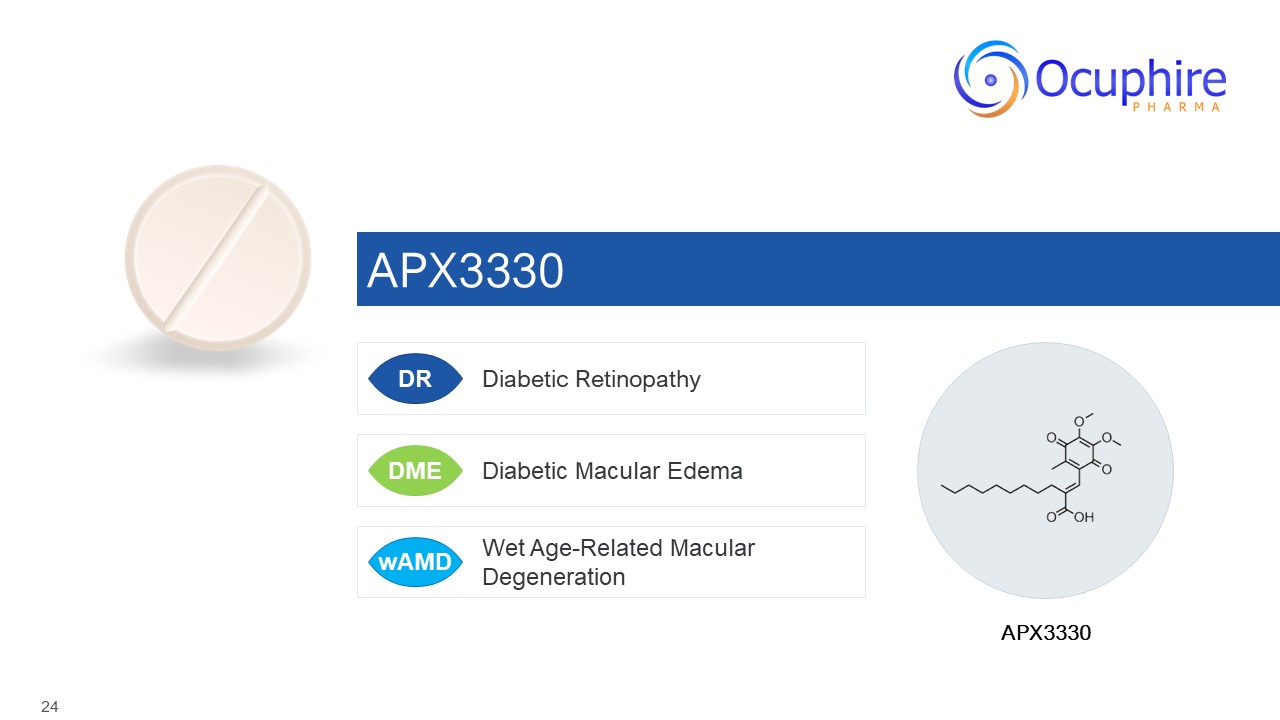
APX3330 APX3330 DR Diabetic Retinopathy DME Diabetic Macular Edema wAMD Wet
Age-Related Macular Degeneration
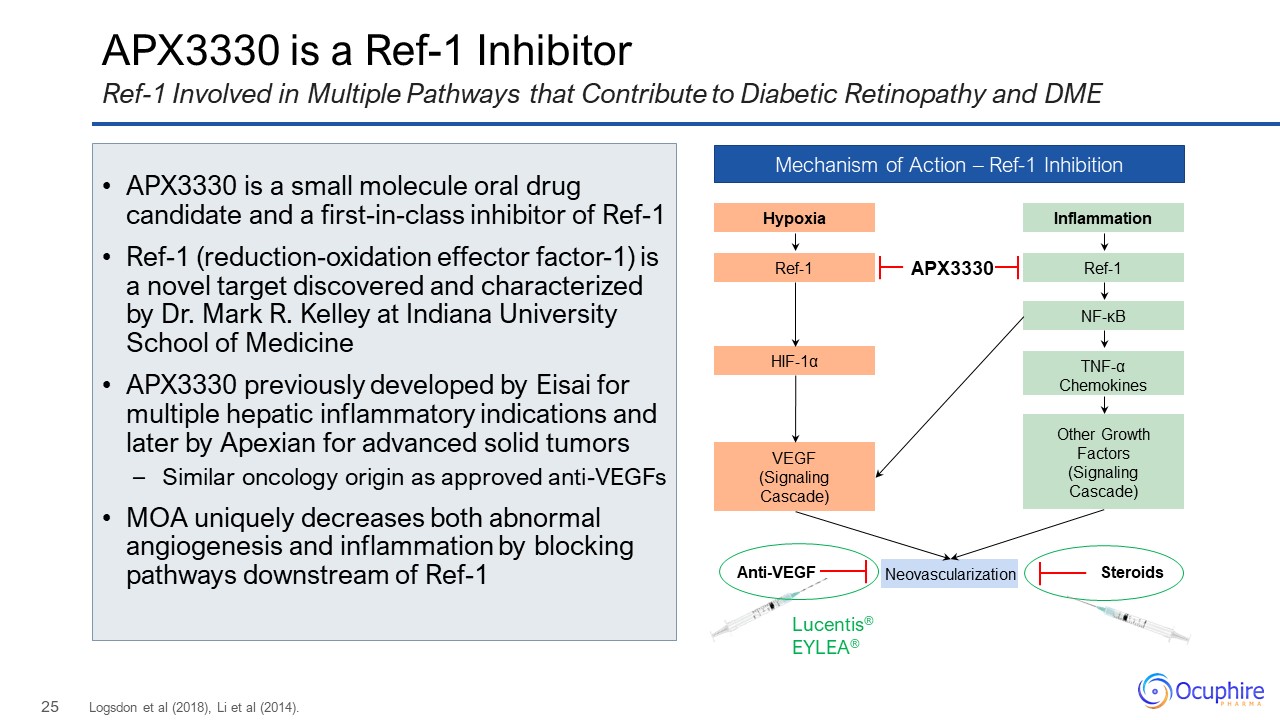
APX3330 is a Ref-1 Inhibitor Ref-1 Involved in Multiple Pathways that Contribute to Diabetic
Retinopathy and DME Mechanism of Action – Ref-1 Inhibition Hypoxia Ref-1 HIF-1α VEGF(Signaling Cascade) Inflammation Ref-1 NF-κB Other Growth Factors(Signaling
Cascade) TNF-αChemokines Neovascularization Lucentis®EYLEA® Anti-VEGF Steroids APX3330 Logsdon et al (2018), Li et al (2014). APX3330 is a small molecule oral drug candidate and a first-in-class inhibitor of Ref-1Ref-1
(reduction-oxidation effector factor-1) is a novel target discovered and characterized by Dr. Mark R. Kelley at Indiana University School of MedicineAPX3330 previously developed by Eisai for multiple hepatic inflammatory indications and later by
Apexian for advanced solid tumorsSimilar oncology origin as approved anti-VEGFsMOA uniquely decreases both abnormal angiogenesis and inflammation by blocking pathways downstream of Ref-1

APX3330 Product Candidate Profile First-in-Class Ref-1 Inhibitor Phase 2 Ready for Retina
Diabetic Indications Improving Eye Health in Diabetics ↓ Inflammation ↓ Hypoxia Signaling ↓ Abnormal AngiogenesisEnhance Compliance & ExposureOral pill may reduce the burden of frequent anti-VEGF injections Few Systemic Adverse EffectsMild
Gastrointestinal (diarrhea)Mild Skin Rash (Reversible)Lack of Significant Acute Neurologic, Cardiovascular, Liver, or Pulmonary toxicityNo Topical EffectsNo observed ocular AEs Safety Data Expected Efficacy Data APX3330: 600mg Oral Dose (120mg
or 300mg tablets) Twice a day dosing of APX3330 being developed to providesteady state effectiveness with a tolerable chronic safety profile
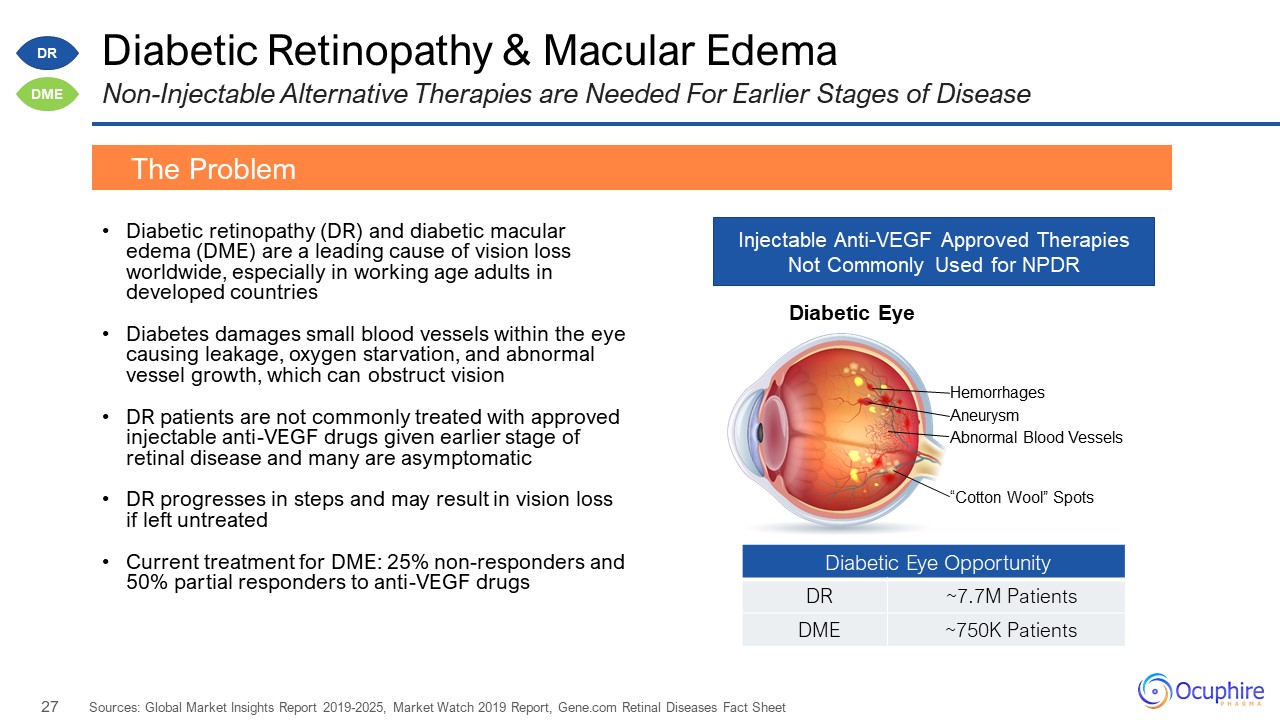
Diabetic Eye Opportunity DR ~7.7M Patients DME ~750K Patients Diabetic Retinopathy &
Macular Edema Diabetic retinopathy (DR) and diabetic macular edema (DME) are a leading cause of vision loss worldwide, especially in working age adults in developed countriesDiabetes damages small blood vessels within the eye causing leakage,
oxygen starvation, and abnormal vessel growth, which can obstruct visionDR patients are not commonly treated with approved injectable anti-VEGF drugs given earlier stage of retinal disease and many are asymptomaticDR progresses in steps and may
result in vision loss if left untreatedCurrent treatment for DME: 25% non-responders and 50% partial responders to anti-VEGF drugs Sources: Global Market Insights Report 2019-2025, Market Watch 2019 Report, Gene.com Retinal Diseases Fact
Sheet The Problem Non-Injectable Alternative Therapies are Needed For Earlier Stages of Disease Injectable Anti-VEGF Approved TherapiesNot Commonly Used for NPDR “Cotton Wool” Spots Aneurysm Hemorrhages Diabetic Eye Abnormal Blood
Vessels DR DME
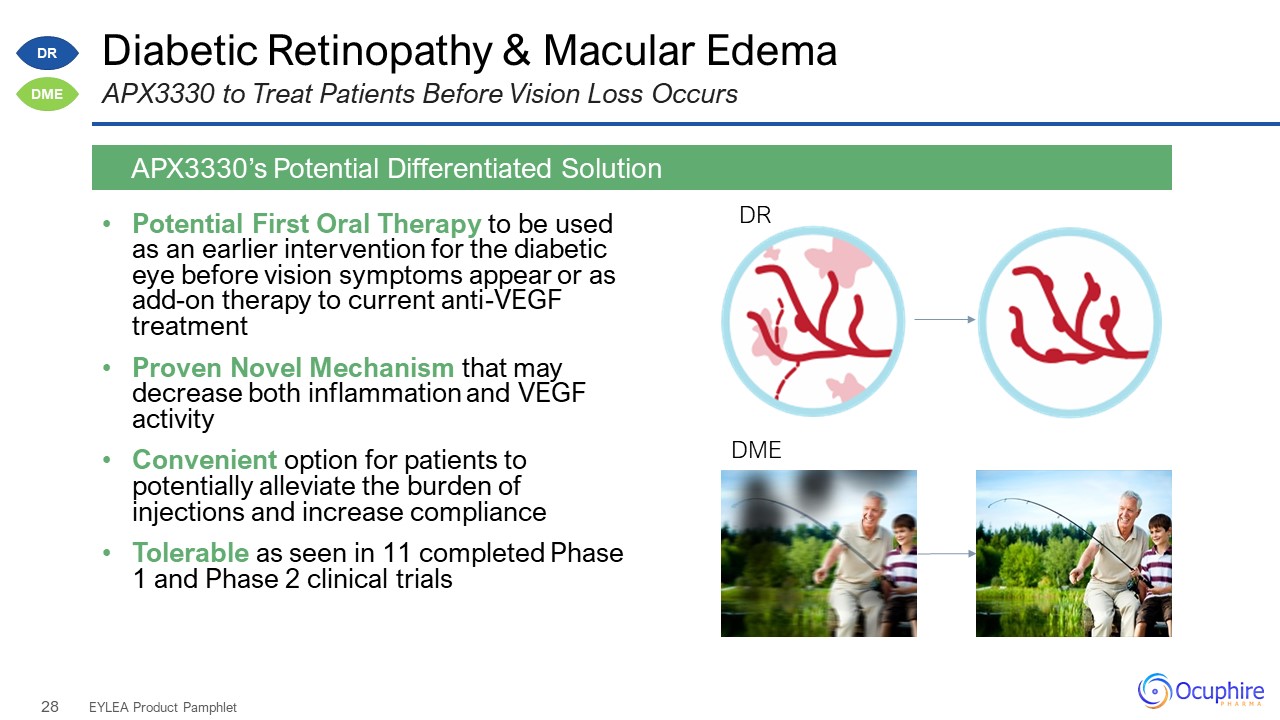
Diabetic Retinopathy & Macular Edema Potential First Oral Therapy to be used as an earlier
intervention for the diabetic eye before vision symptoms appear or as add-on therapy to current anti-VEGF treatmentProven Novel Mechanism that may decrease both inflammation and VEGF activityConvenient option for patients to potentially alleviate
the burden of injections and increase complianceTolerable as seen in 11 completed Phase 1 and Phase 2 clinical trials EYLEA Product Pamphlet APX3330’s Potential Differentiated Solution APX3330 to Treat Patients Before Vision Loss Occurs
DR DME DR DME
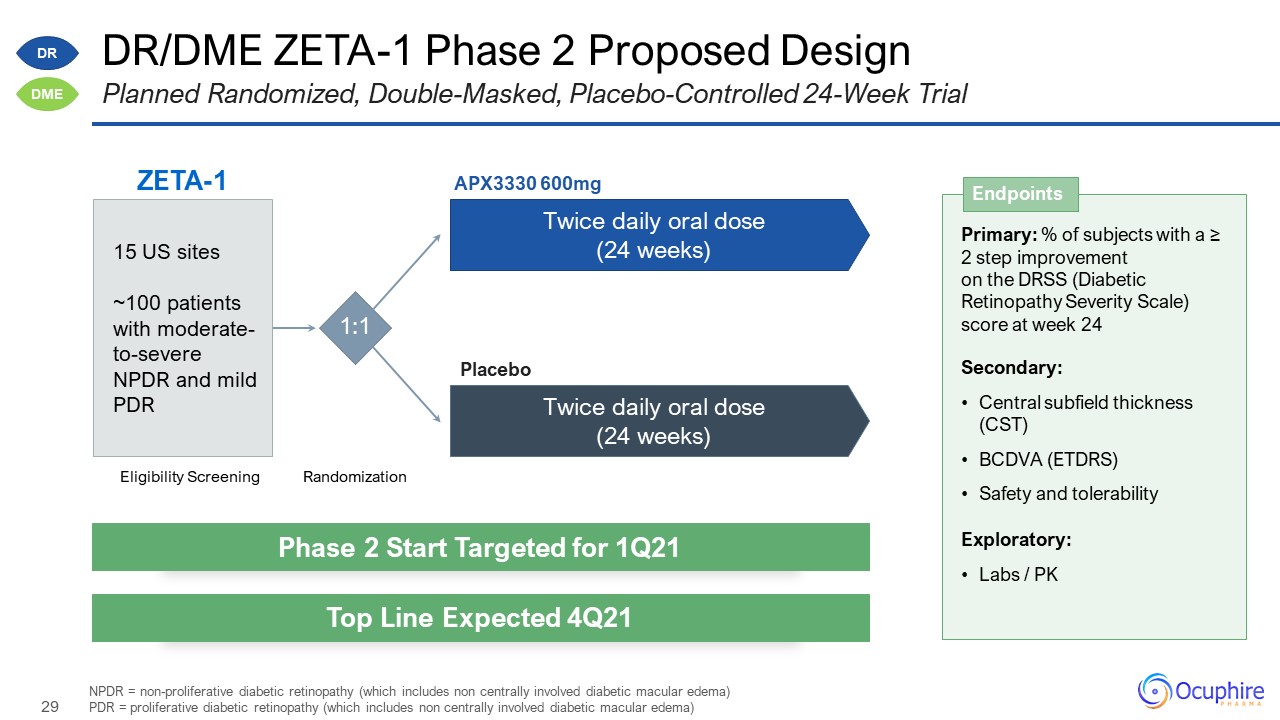
DR/DME ZETA-1 Phase 2 Proposed Design NPDR = non-proliferative diabetic retinopathy (which
includes non centrally involved diabetic macular edema)PDR = proliferative diabetic retinopathy (which includes non centrally involved diabetic macular edema) Planned Randomized, Double-Masked, Placebo-Controlled 24-Week
Trial ZETA-1 Eligibility Screening Randomization 1:1 Twice daily oral dose (24 weeks) Twice daily oral dose (24 weeks) APX3330 600mg Placebo 15 US sites~100 patients with moderate-to-severe NPDR and mild PDR DR DME Primary: % of
subjects with a ≥ 2 step improvement on the DRSS (Diabetic Retinopathy Severity Scale) score at week 24Secondary:Central subfield thickness (CST)BCDVA (ETDRS)Safety and tolerabilityExploratory:Labs / PK Endpoints Phase 2 Start Targeted for
1Q21 Top Line Expected 4Q21
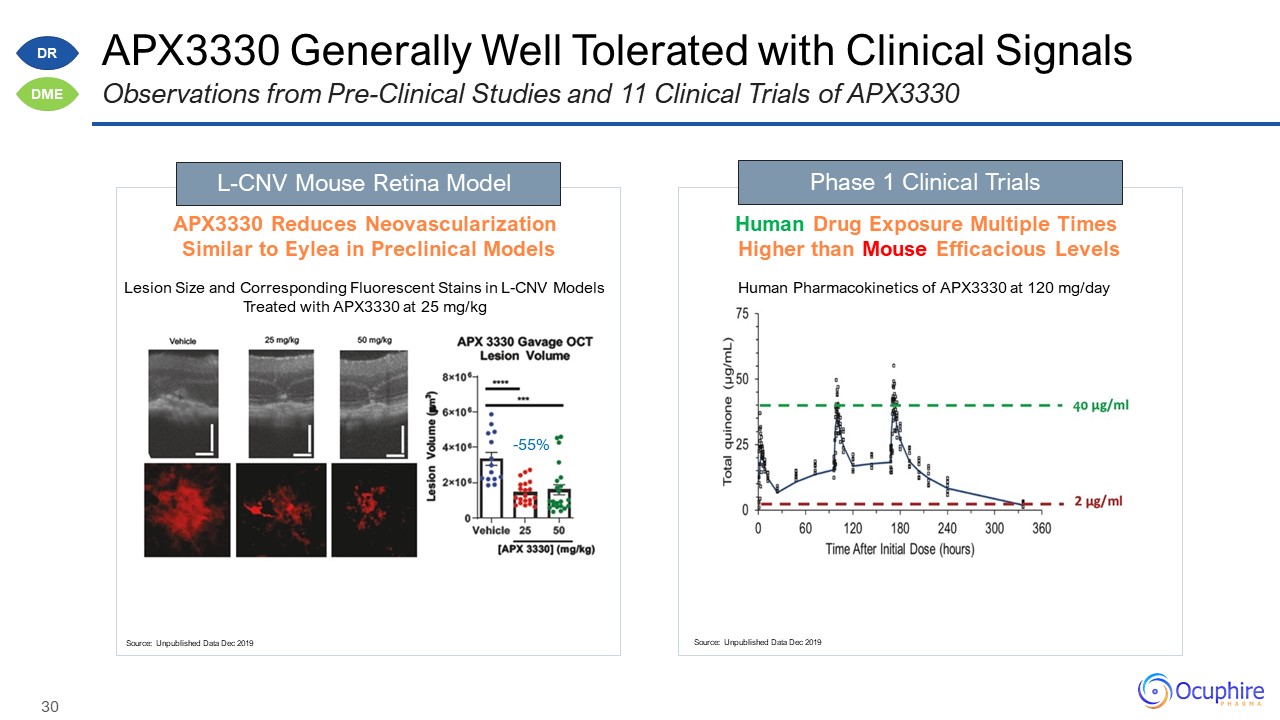
APX3330 Generally Well Tolerated with Clinical Signals Observations from Pre-Clinical
Studies and 11 Clinical Trials of APX3330 Source: Unpublished Data Dec 2019 Lesion Size and Corresponding Fluorescent Stains in L-CNV Models Treated with APX3330 at 25 mg/kg Human Pharmacokinetics of APX3330 at 120 mg/day Source: Unpublished
Data Dec 2019 -55% DR DME Phase 1 Clinical Trials L-CNV Mouse Retina Model APX3330 Reduces Neovascularization Similar to Eylea in Preclinical Models Human Drug Exposure Multiple Times Higher than Mouse Efficacious Levels
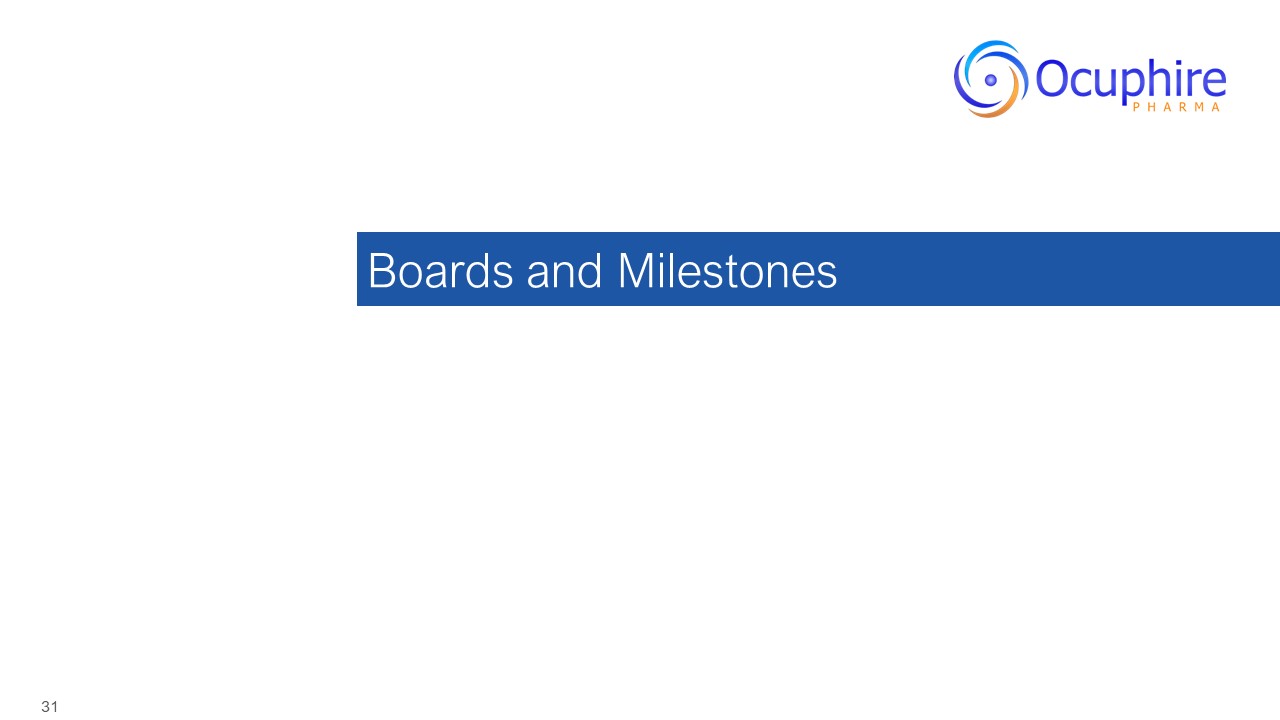
Boards and Milestones
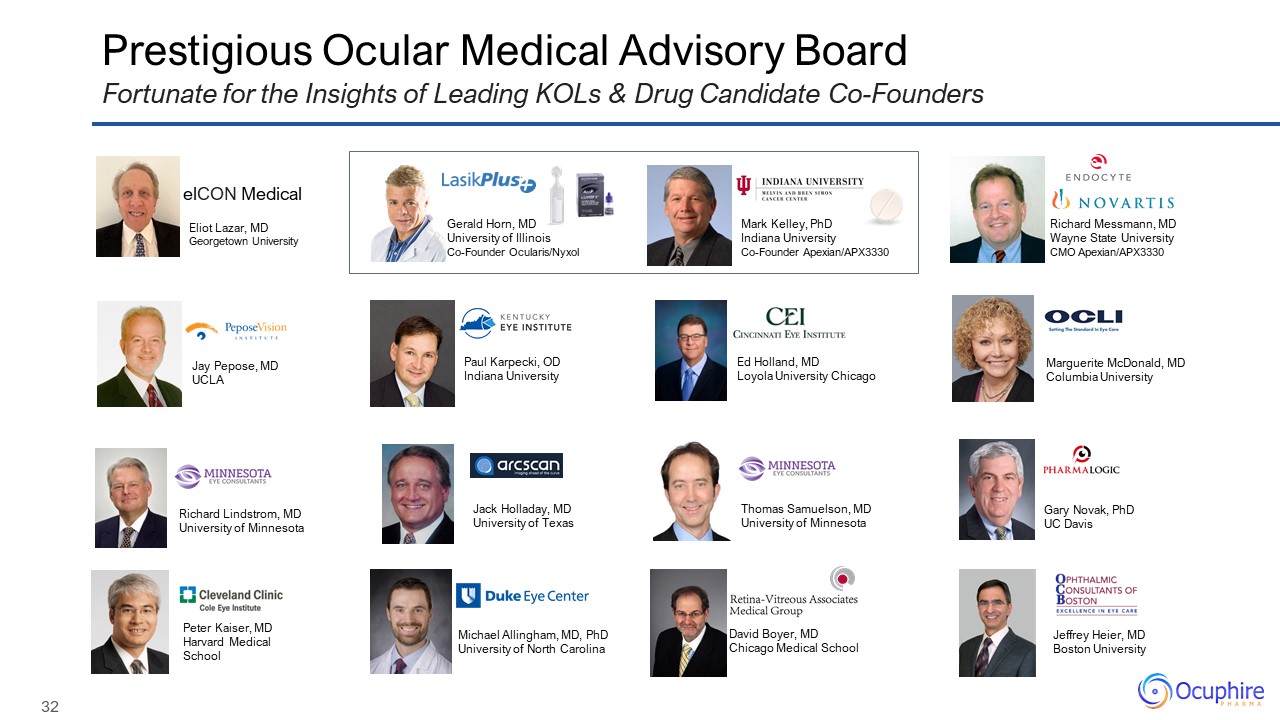
Richard Lindstrom, MDUniversity of Minnesota Ed Holland, MDLoyola University Chicago Jay
Pepose, MDUCLA Jack Holladay, MDUniversity of Texas Thomas Samuelson, MDUniversity of Minnesota Paul Karpecki, ODIndiana University Eliot Lazar, MDGeorgetown University Gary Novak, PhDUC Davis Marguerite McDonald, MDColumbia
University David Boyer, MDChicago Medical School Gerald Horn, MDUniversity of IllinoisCo-Founder Ocularis/Nyxol Mark Kelley, PhDIndiana UniversityCo-Founder Apexian/APX3330 Prestigious Ocular Medical Advisory Board Fortunate for the
Insights of Leading KOLs & Drug Candidate Co-Founders elCON Medical Michael Allingham, MD, PhDUniversity of North Carolina Richard Messmann, MDWayne State UniversityCMO Apexian/APX3330 Peter Kaiser, MDHarvard Medical School Jeffrey
Heier, MDBoston University
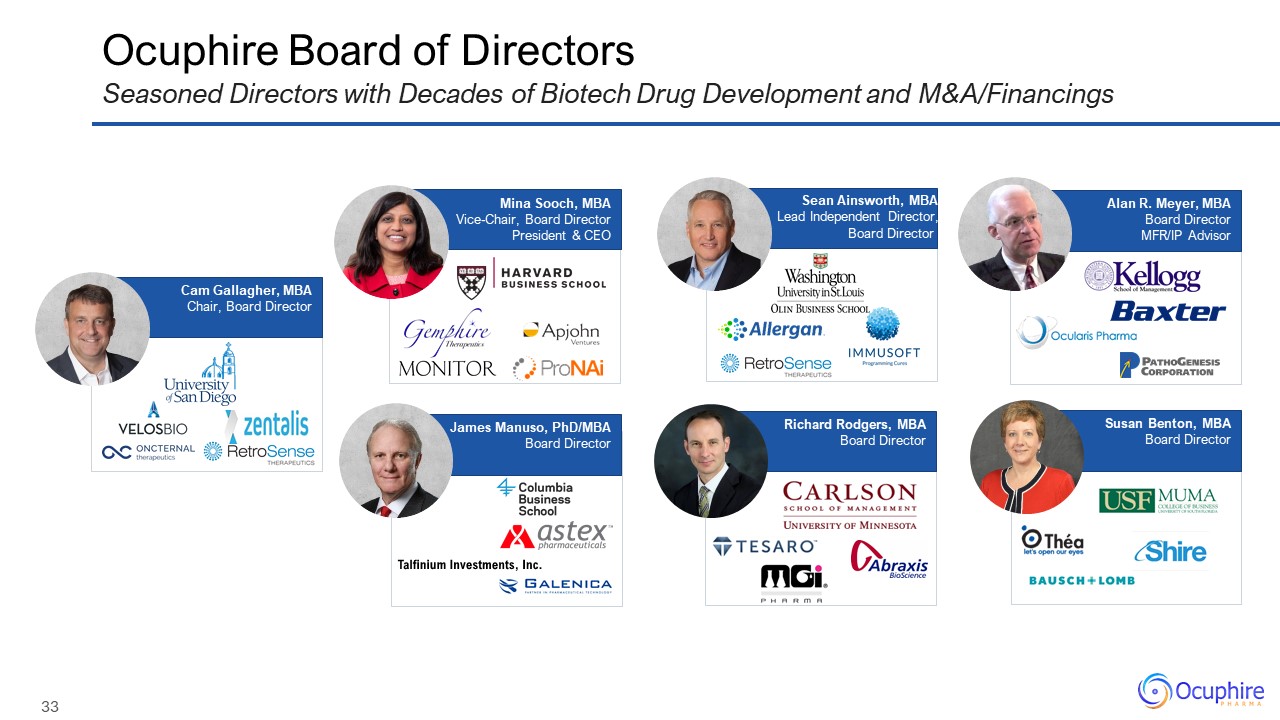
Ocuphire Board of Directors Seasoned Directors with Decades of Biotech Drug Development and
M&A/Financings Sean Ainsworth, MBALead Independent Director, Board Director James Manuso, PhD/MBABoard Director Alan R. Meyer, MBABoard DirectorMFR/IP Advisor Richard Rodgers, MBABoard Director Susan Benton, MBABoard
Director Cam Gallagher, MBAChair, Board Director Mina Sooch, MBAVice-Chair, Board Director President & CEO
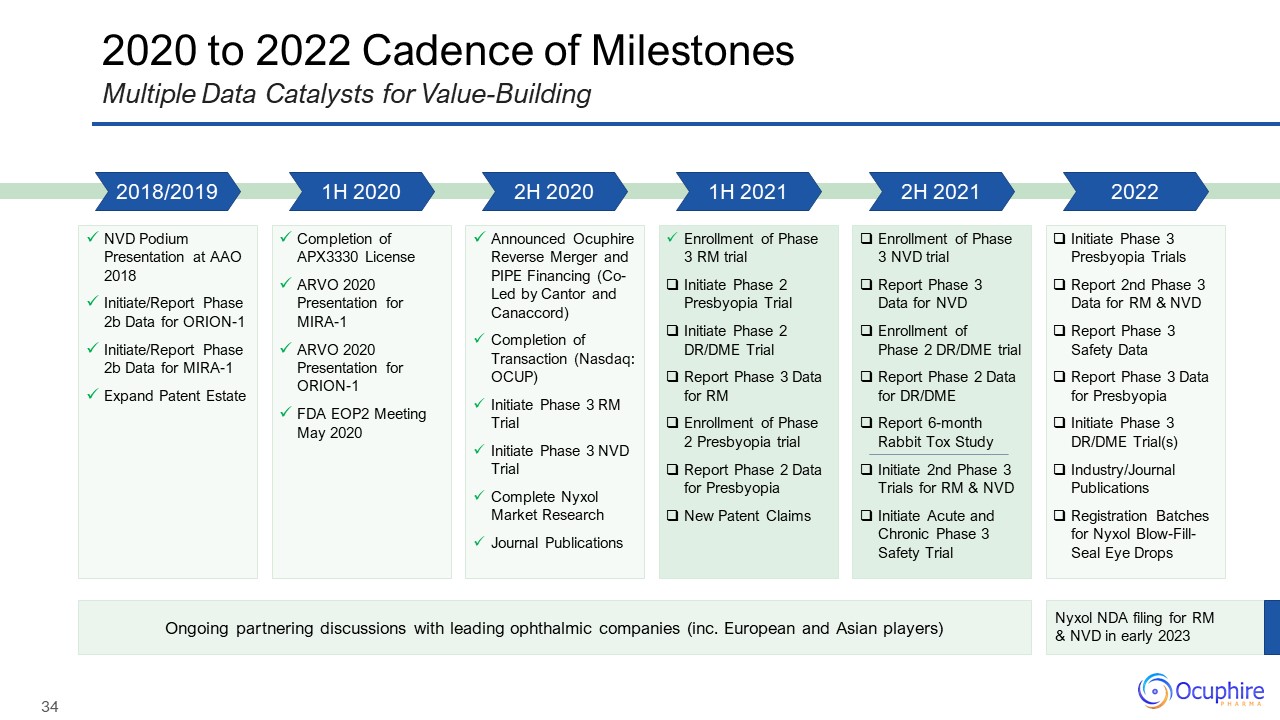
2020 to 2022 Cadence of Milestones Multiple Data Catalysts for Value-Building Nyxol NDA
filing for RM & NVD in early 2023 Ongoing partnering discussions with leading ophthalmic companies (inc. European and Asian players) NVD Podium Presentation at AAO 2018 Initiate/Report Phase 2b Data for ORION-1Initiate/Report Phase 2b Data
for MIRA-1Expand Patent Estate Completion of APX3330 LicenseARVO 2020 Presentation for MIRA-1ARVO 2020 Presentation for ORION-1FDA EOP2 Meeting May 2020 Announced Ocuphire Reverse Merger and PIPE Financing (Co-Led by Cantor and
Canaccord)Completion of Transaction (Nasdaq: OCUP)Initiate Phase 3 RM TrialInitiate Phase 3 NVD TrialComplete Nyxol Market ResearchJournal Publications Enrollment of Phase 3 RM trialInitiate Phase 2 Presbyopia TrialInitiate Phase 2 DR/DME
TrialReport Phase 3 Data for RMEnrollment of Phase 2 Presbyopia trialReport Phase 2 Data for PresbyopiaNew Patent Claims Enrollment of Phase 3 NVD trialReport Phase 3 Data for NVDEnrollment of Phase 2 DR/DME trialReport Phase 2 Data for
DR/DMEReport 6-month Rabbit Tox StudyInitiate 2nd Phase 3 Trials for RM & NVD Initiate Acute and Chronic Phase 3 Safety Trial Initiate Phase 3 Presbyopia TrialsReport 2nd Phase 3 Data for RM & NVDReport Phase 3 Safety DataReport Phase
3 Data for PresbyopiaInitiate Phase 3 DR/DME Trial(s)Industry/Journal PublicationsRegistration Batches for Nyxol Blow-Fill-Seal Eye Drops 2018/2019 1H 2020 2H 2020 1H 2021 2H 2021 2022

www.ocuphire.comir@ocuphire.com
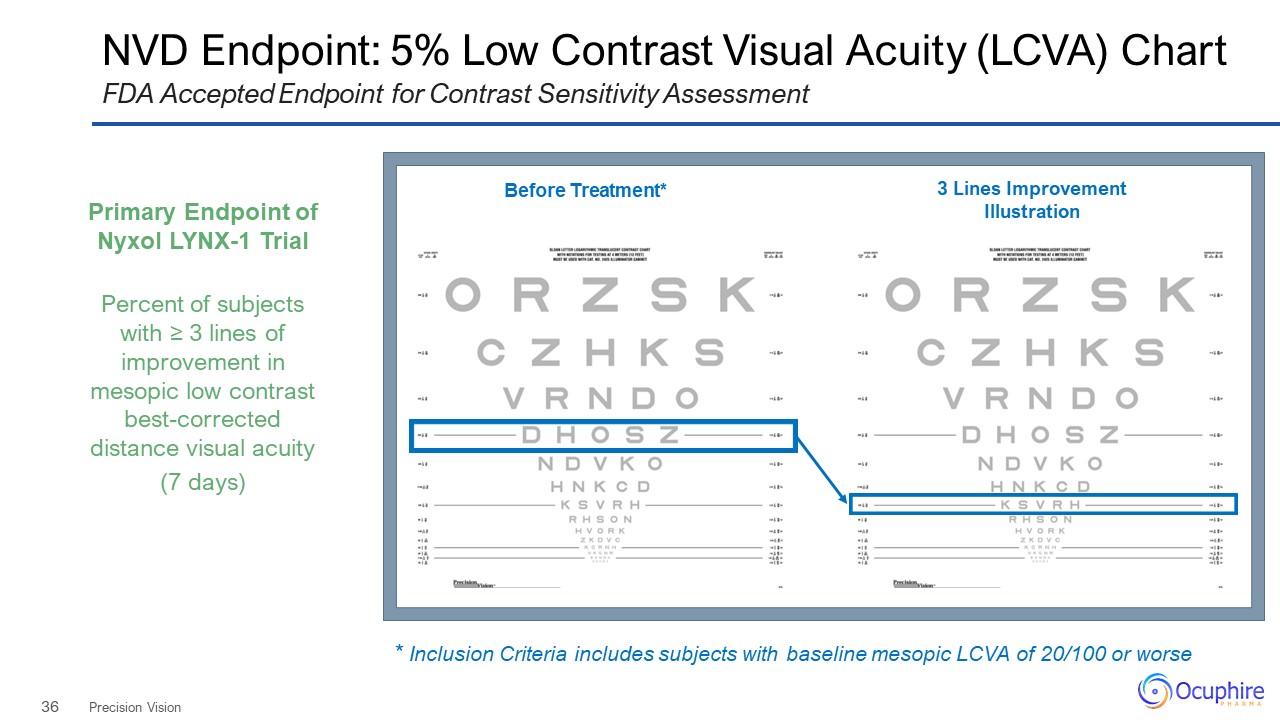
NVD Endpoint: 5% Low Contrast Visual Acuity (LCVA) Chart Precision Vision FDA Accepted
Endpoint for Contrast Sensitivity Assessment Before Treatment* 3 Lines Improvement Illustration Primary Endpoint of Nyxol LYNX-1 Trial Percent of subjects with ≥ 3 lines of improvement in mesopic low contrast best-corrected distance
visual acuity (7 days) * Inclusion Criteria includes subjects with baseline mesopic LCVA of 20/100 or worse
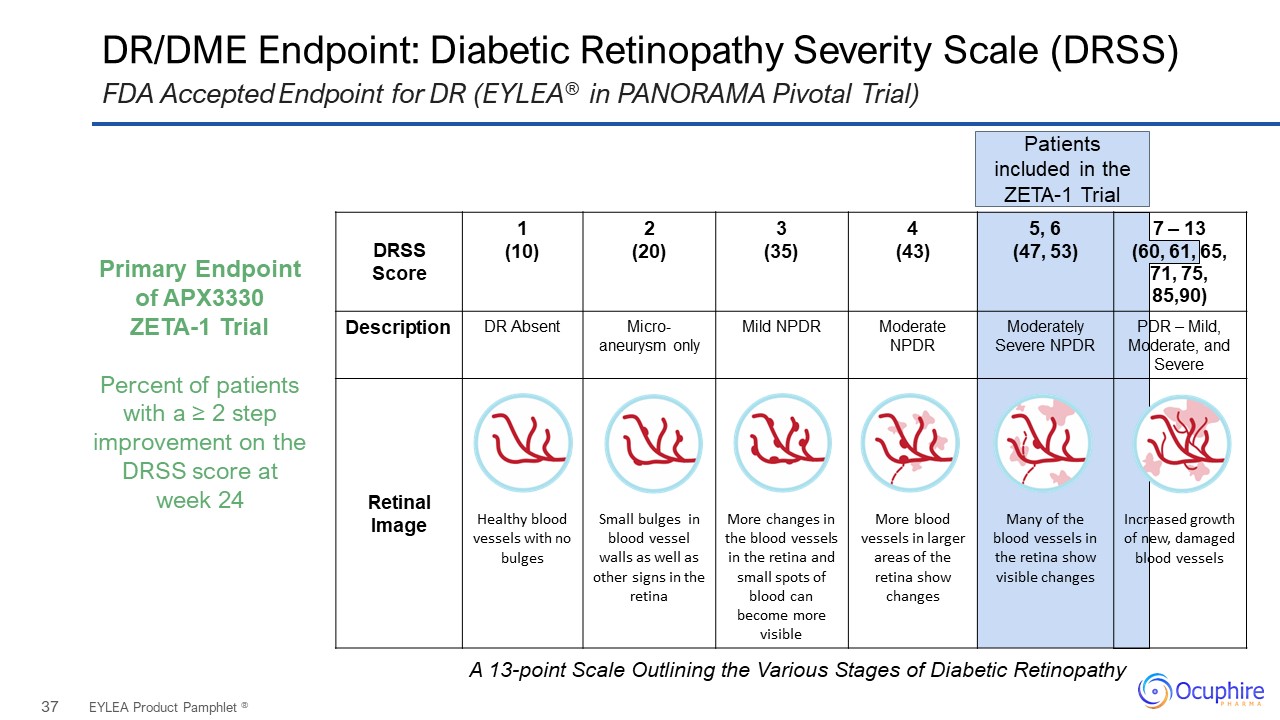
DR/DME Endpoint: Diabetic Retinopathy Severity Scale (DRSS) EYLEA Product Pamphlet
® FDA Accepted Endpoint for DR (EYLEA® in PANORAMA Pivotal Trial) Patients included in the ZETA-1 Trial Primary Endpoint of APX3330 ZETA-1 Trial Percent of patients with a ≥ 2 step improvement on the DRSS score at week 24 A 13-point Scale
Outlining the Various Stages of Diabetic Retinopathy DRSS Score 1 (10) 2 (20) 3 (35) 4 (43) 5, 6 (47, 53) 7 – 13 (60, 61, 65, 71, 75, 85,90) Description DR Absent Micro-aneurysm only Mild NPDR Moderate NPDR Moderately Severe
NPDR PDR – Mild, Moderate, and Severe Retinal Image Healthy blood vessels with no bulges Small bulges in blood vessel walls as well as other signs in the retina More changes in the blood vessels in the retina and small spots of
blood can become more visible More blood vessels in larger areas of the retina show changes Many of the blood vessels in the retina show visible changes Increased growth of new, damaged blood vessels